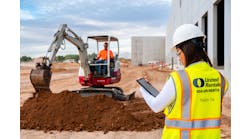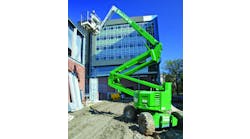When RSC Equipment Rental decided to implement a sustainability plan for its 460 national rental stores, the company wasn't thinking about the money such a plan would save it. Rather, RSC executives were setting out to “do the right thing,” by changing some of the ways it operated and setting into motion some practices that would not only be better for the environment, but would also improve the way its employees felt about the company. RER heard this sentiment again and again as it interviewed sources for this article — what often started out as just doing what was right as responsible corporate stewardship turned out to have the added benefit of saving rental companies money in utility and operating costs.
In the case of RSC Equipment, not only is the company reaping the cost savings of its green efforts, but it is using its knowledge of sustainability best practices to save its rental customers money as well.
“With our sustainable business initiative, we are making great strides to reduce our carbon footprint and lower our environmental burden,” said Heather Schlichting, corporate communications specialist and member of the internal environmental taskforce for Scottsdale, Ariz.-based RSC Equipment Rental. “We believe that our knowledgeable staff can help customers with jobsite challenges regarding environmental compliance, permits, runoff, waste disposal and other related issues. These new efficiencies help the customer save time and money by doing business with RSC.”
Rolled out this month in conjunction with Earth Day, April 22, RSC has implemented multiple green initiatives such as installing low-emittance, high-solar-gain e-glass; insta-hot water heaters; T-5 high-efficiency fluorescent lighting; occupancy sensors on lighting; cool roof technology, which reflects more of the sun's infrared energy and combats the urban heat island effect to reduce air conditioning expense by 25 to 50 percent annually; and upgraded insulation in its newly opened locations. In addition, the company has retrofitted existing locations with T-5 lighting, HVAC upgrades and has used local yard rock instead of shipping it in from a great distance and using unnecessary fuel.
That's not all. At some branches the company has installed low-flow toilets and faucets, Energy Star-qualified CFL light bulbs, and updated its dispatch systems to reduce unnecessary delivery trips, which significantly saves on fuel consumption and the related cost. The company also has comprehensive recycling efforts in place at all its locations.
It's not only possible to improve the sustainability of new buildings beginning at the design stage, but existing buildings can also implement dozens of cost- and environment-saving improvements. In 2008, RSC Equipment Rental's Garland, Texas, branch implemented a green plan to help reduce energy use and save money. Using many of the company's previously mentioned initiatives, employees at the Garland location retrofitted the building and developed a process that increased recycling efforts, reduced energy expenditures and reduced waste. The plan, which even included planting trees on the property to offset the branch's carbon footprint, consisted of action items contributed by employees at all levels. The result was a savings of $11,000 over a 12-month period.
“It was crucial for the employees to be part of the process and encourage them to find answers to issues in order to fully engage them,” Schlichting says. “They were amazed by their results and take great pride in their accomplishments.
“RSC has worked hard to earn a reputation as a leader in the rental industry — in terms of innovation as well as efficiency and performance,” Schlichting adds. “Our environmentally friendly practices reflect all of these aspects and RSC is making a concerted effort to be more ‘green,’ and to help our customers do the same.”
While getting started may seem a daunting task, there are various steps any-sized rental company can take to set their own sustainability plan in motion. A series of small, relatively inexpensive initiatives implemented over the course of a set time period can yield significant energy savings along with the associated cost savings.
Continue on Page 2
With many rental businesses currently experiencing a slowdown as a result of the recessionary economy and the downturn in construction, chances are that these companies are not as busy now as they were a year or two ago. With a little extra time and manpower to devote to creating a sustainability plan, 2009 might be the perfect time to start taking small steps to improve your rental company's green initiatives, setting up the company to bear the returns by the time the economy begins to pick up steam.
To get started, RSC Equipment recommends establishing a cross-functional team of employees to develop new ways to conserve resources and reduce waste. In addition, it suggests auditing the amount of waste created, establishing which items are the biggest contributors to that waste, and then determining the expenses associated with that waste and its disposal.
For detailed information about the hundreds of ways a rental company can reduce energy consumption, reduce waste, reduce its carbon footprint, and effect a positive environmental and cost-saving change on the planet and its bottom line, the newly established “green team” can turn to a number of government organizations to learn the facts. For a thorough introduction to retrofitting a rental facility to improve its sustainability, turn to the U.S. Green Building Council's Leadership in Energy & Environmental Design (LEED) for Existing Buildings document, which is available for download at www.usgbc.org/ShowFile.aspx?DocumentID=3617.
LEED the way
LEED defines a sustainable building as one that maximizes operational efficiency while minimizing environmental impacts. Its Design for Existing Buildings: Operations & Maintenance Rating System serves as a good road map for property managers who wish to drive down a commercial building's operating costs while increasing the occupants' productivity in an environmentally responsible way. The rating system is a set of voluntary performance standards designed to provide an entry point to the LEED certification process for existing buildings.
The system addresses building exterior and site maintenance programs, efficient and optimized use of energy and water, the purchase of environmentally preferred products, waste stream management as well as ongoing indoor environmental quality. The rating system also provides guidelines for whole-building cleaning and maintenance, recycling programs and systems upgrades to improve building energy performance, and water consumption.
“The LEED Operations & Maintenance rating system gives people who just have a regular building a look at what it would take to upgrade it,” says John Freshnock, principal of Williams, Spurgeon, Kuhl and Freshnock Architects, a Kansas City, Mo.-based architecture firm with experience in LEED building design. “It gives you a framework to look at what all the potential strategies might be.”
Rental companies can choose to use LEED's guidelines as a means to measure their progress on a facility's sustainability improvements or they can choose to pursue LEED certification, which can add value to the building and lead to potential tax benefits.
Henderson, Nev.-based Cashman Equipment, a Caterpillar dealership and Cat Rental Store originally founded in 1931, earlier this year opened its new headquarters facility, which is recognized as the largest LEED-designated industrial complex in Nevada, and the company expects to receive its official LEED Gold designation from USGBC in early summer.
Continue on Page 3
The new 53-acre, seven-building, 308,000-square-foot headquarters facility is constructed with sustainable materials such as concrete tilt-up panels containing 15 percent fly ash; terrazzo tile containing 50 percent recycled glass; and more than 3,500 high-performance glass panels. During construction, 40 percent of all the materials used came from the local region, and 818 tons of construction debris was diverted from local landfills and recycled. Using USGBC's LEED for New Construction rating system, Cashman Equipment received between 60 to 79 points for those green elements, as well as for how the project affects the local Nevada region, to qualify for its LEED Gold designation.
Similar to RSC Equipment, Cashman pursued green construction in its new headquarters for the dual purpose of responsible corporate citizenship and for the mutual benefit to its employees.
“The abundant environmental benefits may be the most apparent reason for a company to ‘go green,’ but it was not Cashman's only consideration,” says CEO and chairman MaryKaye Cashman. “The benefits to our employees' well-being were also of paramount importance.”
“The decision to ‘go green’ makes sound economic sense, but we would have pursued LEED certification even if it didn't have economic payback because it's the right thing to do,” said Mike Pack, Cashman Equipment president and chief operating officer. “However, we will see the payback in energy savings on our geothermal investment within seven years.”
Like RSC, Cashman recognizes the value to employee satisfaction as well.
“The combination of all these elements elevates employee productivity and retention, improves the customers' experience, and sets an example for the construction industry,” adds Kate Graziano, marketing coordinator for Cashman Equipment.
Another Caterpillar dealership and Cat Rental Store that recently opened a new “green” campus is Kansas City, Mo.-based Dean Machinery Co. Like RSC Equipment and Cashman, Dean Machinery employs motion detectors throughout many areas of its facilities to control lighting and reduce electrical usage, and has a comprehensive recycling program. It uses automated toilets and faucets to reduce water consumption, and takes advantage of natural light to further reduce the need for energy consumption.
The new Dean Machinery headquarters, which were opened in October 2008, uses onsite renewable energy sources, including waste oil, which is used for heating. In addition, all chemicals and cleaners are environmentally friendly, down to the hand soap used in the shop and restrooms. In addition, an exhaust system at each service bay filters exhaust fumes outdoors, and a system of hoses connected to master tanks fill equipment with fuels and other fluids without the threat of spills.
“The new headquarters is a clear indication of our commitment to our customers, our employees, the industries we serve and the Kansas City community,” says Lori Dean, president, Dean Machinery. “It shows that we're on track and growing for the future.”
For its efforts, Dean Machinery is pursuing the Silver LEED designation under USGBC's LEED for New Construction rating system.
Options aplenty
While LEED outlines hundreds of steps to get a rental company started on improving its sustainability, there are also specialized products available to rental companies that can help.
Continue on Page 4
Tires are one of the biggest consumable products used in the rental business and a major source of waste and contributor to landfills. Last year RSC Equipment Rental launched a solid-tire initiative with aerial work platform and forklift supplier JLG Industries, noting that solid rubber tires last three- to four-times longer than standard or foam-filled tires, which leads to a decrease in down time, costly replacements and a significant reduction in wastes.
Now, as an additional alternative to air-filled rubber tires, rental companies can consider a product from Chattanooga, Tenn.-based Pathway Polymers called TyrFil Recycling Systems. Already in use by Phoenix-based Sunstate Equipment, which has its own tire division across the street from its main branch, Pathway Polymers CEO Joe Danules says the AutoFil Recycler, which is designed for dealers and aftermarket use, provides a huge opportunity for rental businesses to lower their costs associated with filling, replacing and disposing of tires, while offering a responsible alternative to tire replacement.
“We make it less expensive to fill tires and we do it in a green way,” says Danules, who notes that TyrFil is three- to four-times less expensive than solid tires. “Savings of up to 65 percent compared to traditional fill systems are possible even before factoring in environmental disposal cost savings.”
As an example, a rental company filling its own tires in-house using the TyrFil product in combination with used polyfil through the AutoFil Recycler can reduce its virgin polyurethane flat-proofing material requirements by up to 65 percent. So, a rental company that uses 350,000 pounds of fill annually would only need to purchase 122,500 pounds of virgin material. At a current average market price of around $0.90 per pound for virgin TyrFil, this would equate to an annual savings of $204,750 from using this exclusive patented eco-friendly alternative to standard tires.
An easy and effective way to continuously audit a rental business' energy use is to employ one of several available energy and resource management solutions available for commercial applications. Two such solutions are EcoView Commercial from Larkspur, Calif.-based Advanced Telemetry, and Portfolio Manager from Energy Star.
The EcoView system is designed to help business owners control energy and water costs and reduce the environmental impacts of running their businesses. The simple-to-install system empowers users to monitor and manage their resource consumption.
“As economic pressures grow, energy costs rise, profit margins shrink and environmental responsibility becomes more vital, we are offering businesses a solution to easily reduce the costly waste of energy and other resources,” says Gus Ezcurra, CEO of Advanced Telemetry. “With EcoView Commercial, businesses can, in a simple and achievable way, help their bottom lines and the health of the planet at the same time.”
Using EcoView, rental companies can monitor temperature set-points and settings, schedules, electricity and water consumption, follow trends, track changes, identify key culprits of energy drain, set consumption goals, and directly control how resources are being used and indentify resource waste. Though the return on investment from installing the EcoView system is influenced by a number of variables including location of the business, date of building construction and the presence of other energy-efficiency-related equipment in the rental facility, the product will likely pay for itself with achieved resource cost savings in 8 months or less.
The Portfolio Manager from Energy Star is an interactive tool that allows users to track and assess energy and water consumption across a company's entire portfolio of buildings in a secure online environment. The tool is well suited to rental companies with multiple branch locations across a particular region. In addition, Portfolio Manager lets users rate the energy performance of their buildings to determine their Energy Star rating. From there, users can generate a Statement of Energy Performance, which can allow the company to apply for the Energy Star label and satisfy LEED for Existing Buildings requirements, which can make a rental business eligible for tax benefits.
Continue on Page 5
The green horizon
Regardless of its size or whether it is modifying an existing facility to improve its sustainability, or building a new location from the ground up, any rental business can achieve significant operational cost savings by implementing sustainable design elements and employing green products.
With stricter fuel emissions standards, waste disposal issues and water treatment restrictions impacting the rental industry, RSC's Schlichting expects the importance of sustainability awareness to continue growing among both rental companies and their customers.
Contrary to the enduring words of Kermit the Frog, it actually is easy being green. Resources abound, and a few small steps can have a significant impact on the environment and on the bottom line of a rental business. Going the distance and establishing a full-fledged sustainability plan can potentially save each branch of a rental business thousands of dollars in energy and waste savings annually.
Tell us what your rental company is doing to “go green.” E-mail Brandey Smith at [email protected].
20 Tips to Improve Your Company's Sustainability
- Add designated recycle containers for paper, plastic, aluminum, cardboard, old cell phones, PDAs and pagers, batteries from cordless power tools, laptop computers, construction equipment and outdoor power equipment to accommodate all recycling needs.
- Install automatic motion light switches in offices and public areas to be more energy efficient and reduce electric bills.
- Convert all lighting to high-efficiency bulbs and examine where lighting can be reduced.
- Find a shredding service to recycle unwanted, corporate sensitive documents.
- Recycle ink cartridges and toner in exchange for retail coupons or donate to charity.
- When printing documents, use the double-sided printing option to use less paper.
- Enable power management features on all computers and monitors so they go into sleep mode when idle.
- For guides, catalogs and other company publications, select a print vendor who will use low VOC (volatile organic compounds) ink and recycled paper.
- Install a digital thermostat to regulate heating and cooling to reduce energy expenses.
- If repainting or sealing is needed, choose products with low to no VOCs.
- Purchase recycled supplies that are recyclable and made from recycled materials to reduce waste.
- Install low-flow faucets and toilets in public restrooms to conserve water. Other examples could include dual flush toilets and waterless urinals.
- Purchase materials from local vendors to decrease transportation emissions and costs.
- Use only sustainable cleaning products to avoid products that are harmful to the environment and human health.
- To stop drafts, install weather stripping around doors and caulk cracks around windows. Check the heating and cooling systems' ducts to make sure all joints are connected and well sealed.
- Employ an energy audit to assess how efficient the building is in terms of energy and water consumption.
- Replace any break room appliances with Energy Star-rated appliances, which can reduce their energy consumption by 10 to 50 percent annually.
- Plant high-efficiency irrigation landscaping on the premises to reduce the amount of watering necessary.
- Choose high-efficiency, reflective or double-pane windows when the time comes for replacement.
- When replacing the roof, use materials with cool roof technology to reflect more of the sun's heat to lower the roof's temperature by up to 100 degrees.
Information compiled and provided by RSC Equipment Rental and U.S. Green Building Council.
Continue on Page 7
Green Resources
Advanced Telemetry - Manufacturers of EcoView climate control and resource management system.
www.advancedtelemetry.com
Energy Star - Offers tips for raising energy awareness among employees and outlines tax deductions for achieving energy efficiency in commercial buildings.
www.energystar.gov
Environmental Protection Agency - A general resource for information on human health and the environment.
www.epa.gov
EPA Green Building - Information from EPA on the growing green building market.
www.epa.gov/greenbuilding/
Good to be Green - Offers financial incentives for using renewable and energy efficient products.
www.goodtobegreen.com
Green Seal - An independent, non-profit organization that promotes the manufacture and purchase of environmentally responsible products and services.
www.greenseal.org
U.S. Department of Energy - Provides information on energy efficiency and renewable energy.
www.eere.energy.gov/
U.S. Green Building Council - A non-profit organization that certifies sustainable businesses, homes, hospitals, schools and neighborhoods. USGBC is dedicated to expanding green building practices and education, and its LEED Green Building Rating System.
www.usgbc.org





